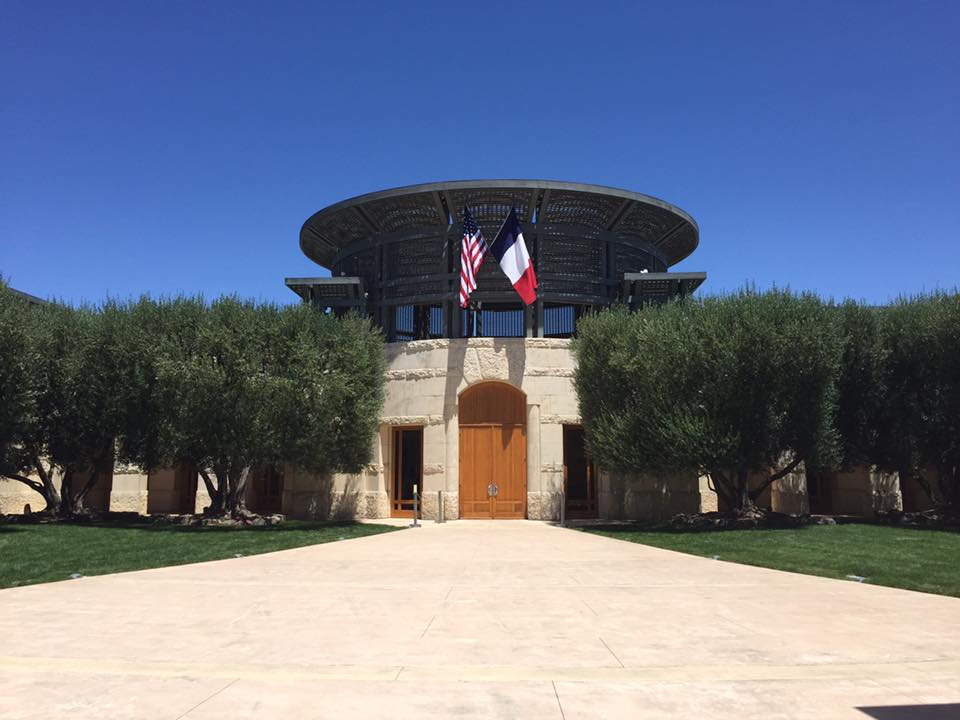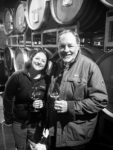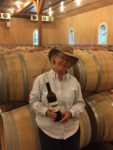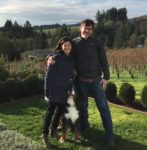OPUS ONE
A diamond in California lush vine
Since the early 1970s, Baron Philippe de Rothschild observed an increase in the quality and expertise in the wine production in Napa Valley. This, combined with a promising terroir as well as a desire to produce Californian wine, were two important factors to make his will a reality; but only one thing was missing, for Baron Philippe de Rothschild to open a vineyard in Napa: an alliance with a local player.
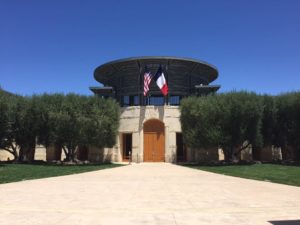 The meeting of two legends of wine
The meeting of two legends of wine
Baron Philippe de Rothschild, who admired the work of one of the pioneers in the production of Californian wine decided to meet him, Mr. Robert Mondavi in 1970.
This first conversation on the island of Maui (one of the Hawaiian Islands) resulted in an invitation to Mr. Mondavi to come to France, more specifically, to the Château Mouton Rothschild.
The trip took place but there was no discussion of a possible joint venture with the Californian winemaker, until… the last day. Just before Mr. Mondavi’s departure, Baron Philippe de Rothschild invited him into his office. In just two hours the outline of what would become the most famous winery in Napa, was decided and written down.
Their will?
Just as a child has characteristics of both parents, he has also his own character. The founders of Opus One wanted their child to have their characteristics, to reflect their wine culture, that said, features that were common to their respective properties, but; they also wanted it to have its own personality, its own style …. a unique style.
In 1979, with its first vintage, Opus One was born. For this first wine, the grapes were brought from the Mondavi property; it was only after that, that their own vineyard with the name Opus One was created.
The Building:
The construction of the building, as we know it today began in 1989 and ended in 1991. The project was entrusted to the famous architect Scott Johnson (A famous architect of the manufacturer Company Transamérica in San Francisco).
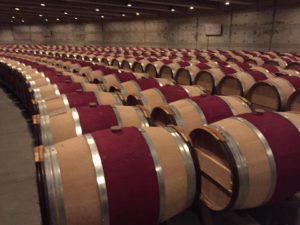 Personally, seeing how it comes out of the ground, it makes me think of a young and strong sprout making her fight to go out of the ground. Perhaps, we can also use the metaphor of a young growing child, a child who draws his strength from the earth. A child who respects traditions (for the limestone and columns of the building), but also open to modernity (the redwood pergola painted, giving it a metallic appearance and therefore contemporary). Apart from that, this building does not break the harmony of the landscape
Personally, seeing how it comes out of the ground, it makes me think of a young and strong sprout making her fight to go out of the ground. Perhaps, we can also use the metaphor of a young growing child, a child who draws his strength from the earth. A child who respects traditions (for the limestone and columns of the building), but also open to modernity (the redwood pergola painted, giving it a metallic appearance and therefore contemporary). Apart from that, this building does not break the harmony of the landscape
Finally, a child that was born from the mixture of European-style and American architectures. The will of their fathers is respected not only in the wine but also in the architecture.
Where do the logo and the name of Opus One come from?
Robert Mondavi and Baron Philippe de Rothschild shared, in addition to the passion for wine, a true love for classical music. They chose a Latin word that was frequently used in musical works: “Opus” to baptize their child together. In addition it was important to the founders that the property name was easily recognizable and pronounceable in English and French.
Regarding the logo, is simply the assembly in the form of the profile signature of the two creators, Robert Mondavi and Baron Philippe de Rothschild.
What is the signature of Opus One wine?
 What differentiates the wines from this property from the other wines, whether Californian, French, Spanish or others, is the creamy texture in the mouth. These wines give a sensation of biting into the fleshy fruit.
What differentiates the wines from this property from the other wines, whether Californian, French, Spanish or others, is the creamy texture in the mouth. These wines give a sensation of biting into the fleshy fruit.
Meeting at the corner of a vine
During my visit to the vineyard I had the chance to meet Nathalie Juré, Assistant Technical Director / Head of Culture of this beautiful property.
A woman that is passionate about the world of wine, Nathalie Juré holds a Master’s degree in agronomy from the University of Montpellier. She began her career in 2003 as an intern at the Château Latour. She then worked in the Chilean Viña Errazuriz vineyard, followed by a maturity project study in 2004 at Opus One. She became Viticulturist in 2008 then Assistant Winemaker /Viticulturist in 2012 working with Michael Silacci, Winemaker at Opus One since 2001.
Today this dynamic assistant winemaker takes to heart the nuances of each year to produce a wine in accordance with the vision of the founding fathers, but also a nectar in which it leaves its mark.
Three words to describe her job?
“Vine“, “precision“, “relationship vineyard / winery” and I would just add “passion” because it really is what comes out of my interview with Nathalie.
Why “vine“? Because we must not forget that the wine comes from the vine, and therefore we must be careful to know how a variety expresses the land, and not just copy and paste techniques. These principles must be adapted to different regions.
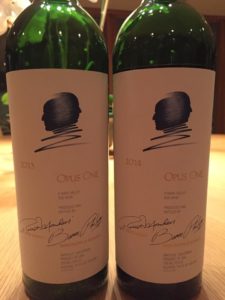 “Relationship vineyard / winery” because we must not forget that without good grapes you cannot make good wine…. the best cellar master of the world can not make good wine with grapes from a badly managed vine. The opposite is true too, the best chef in the world, could produce berries of excellent quality, but if the master of the cellar is not working properly then the grapes used in the creation of the wine is mediocre.
“Relationship vineyard / winery” because we must not forget that without good grapes you cannot make good wine…. the best cellar master of the world can not make good wine with grapes from a badly managed vine. The opposite is true too, the best chef in the world, could produce berries of excellent quality, but if the master of the cellar is not working properly then the grapes used in the creation of the wine is mediocre.
Note to myself: Personally I find that in France, we often put the Master of Cellar/winemaker/technical director on a pedestal, and we forget about the Head of Culture/viticulturist…. except that they both are linked to each other…. one and the other are equally important.
Back to the topic
“Precision“, it is a profession where the detail, in planting young vines and their watering, and also in winemaking (maintenance of the vine, harvest date, winemaking, aging, etc …) are important.
An advice for tasting this wine?
In one word “PATIENCE”.
The anecdote: The Wine Making Team
What? This is a project launched by Michael Silacci, CTO, allowing each employee of Opus One to participate in the development of a wine property. It consists of two teams built around the team Chai. Each year employees of different departments (vineyard, accounting, sales, public relations …) are associated with a team of Chai. A tank is then assigned to each team. Each has the freedom to work from the beginning of a wine harvest until the end of the breeding as they wish (with the sole condition of not making too atypical things). At the end, a blind tasting is organized to see whether the wine can be integrated into a final assembly of Opus One. The objective of this competition is to give each employee a significant role and presence in the Opus one team whose goal is to maintain the absolute quality in wine. But the goal is to break the routine of work.
For the story, that is also unique, is that the Californian vineyards circuit “24h du mans“. Bobard, over-the-row tractors, are used in the vineyards of Opus One. They are difficult to operate, so Michael Silacci and Nathalie Juré created a mock vineyard for tractor drivers to learn to operate the Bobards. The property organizes annual 24 hour training course to learn to manage these machines. In fact in only in a few parts of the Napa property is where those kinds of machine are used due that there is a strong lack of qualified staff to conduct those tractors.
Thanks to Nathalie Juré and the team at Opus One for their reception.
Jonathan Choukroun Chicheportiche
Don’t hesitate to share this article
Opus One
Opus One Shipping Address:
1144 Oakville Cross Road
Oakville, CA 94562
Opus One Physical Address:
7900 St. Helena Highway
P.O. Box 6
Oakville, CA 94562
(707) 944-9442
Website
Facebook
Twitter

